2024 Yamaha Tracer 9 GT+ Review

Riding 950 miles across three states in two days highlights this Tracer’s capabilities
New motorcycle model introductions follow a well-worn path: travel to the event location, eat nice meals, get briefed on the bike of the moment, ride a route designed to highlight the bike’s strengths, take photos/video, eat more good food, return home, and write up a review. After 27 years in this industry, I still get a cheap thrill about throwing a leg over a new motorcycle before it is available to the general public. However, what really gets me going is when I have a chance to log more than just the couple of hundred miles typically covered in an intro and spend some real time on the road with said bike.
For these ride-away events, I typically spend many hours planning and replanning my route home, looking for the optimal balance between exciting roads, beautiful scenery, and realistic travel times. These rides really give me a chance to get to know a motorcycle, provide more information for the review, and have a ton of fun all at the same time. So, with barely contained excitement, I found myself leaving Boise, ID at around 8:00 last Friday morning astride a 2024 Yamaha Tracer 9 GT+ with about 950 miles of riding through three states over two days ahead of me. I was positively giddy.
2024 Yamaha Tracer 9 GT+
The 2024 Yamaha Tracer 9 GT+ makes racking up the miles an almost effortless affair. The inclusion of Adaptive Cruise Control and the Unified Braking System play a major role in improving rider safety while reducing rider fatigue.
Editor's Score: 91.5%
Engine | 18/20 | Suspension | 14/15 | Transmission | 9.25/10 |
Brakes | 9/10 | Instruments | 4.75/5 | Ergonomics | 9/10 |
Appearance | 9/10 | Desirability | 9.5/10 | Value | 9/10 |
Highs
- Seamless integration of radar-linked Unified Braking System
- Adaptive Cruise Control works in the real world
- Seamless quickshifter offers new features
Sighs
- Highly pessimistic fuel gauge
- Garmin Motorize app requires monthly subscription
- Hand guards block cooling breeze
While the Tracer 9 GT+ has been available overseas as a 2023 model, they should start arriving in Yamaha dealerships this month as early release 2024 models in the North American market. Because we are impatient here at MO, we had one of our European freelancers send us a First Ride Review back in May, and we liked what we read. That article only served to increase my anticipation for my extended ride.
2023 Yamaha Tracer 9 GT+ Review – First Ride
A Familiar Engine
Given my familiarity with the 890cc CP3 Triple and the fact that it is unchanged for the GT+ from the GT, I felt immediately at home, ripping the rpms all the way up to its claimed 117 hp peak as I rolled onto Interstate 84 headed southeast towards Mountain Home, ID. The power put out by the Triple is just about perfect in my opinion, and as I would note throughout my ride, the ECU’s fuel mapping is spot on in Street mode (one of four modes, including Street, Sport, Rain, and Custom) and just a hint of abruptness in the off/on-throttle transition. After several iterations of this power plant, it has reached a supremely satisfying state of refinement. That’s not to say it is bland. The howl from the intake, coupled with the exhaust note, makes me want to run up and down through the gears repeatedly.
One of the big changes in the Tracer 9 in its transition to the GT+ is the third generation quickshifter. Not only does it handle all of the usual challenges I throw at these systems when testing them, like up/downshifts in the first two gears at a variety of engine speeds and throttle openings, but also the more mundane tasks of shifting at either sedate speeds or with sporting intents happen in a slippery-smooth fashion with one sole exception.
For 2024, the 890 Triple can also downshift with the throttle open instead of requiring it to be closed and decelerating. So, if you are on a hill and want to bang a downshift to quickly pass a car, you don’t have to roll off the throttle, shift, and roll back on. Instead, just maintain your throttle position and downshift. What you’ll feel is a sensation similar to that of a car with an automatic transmission downshifting into a passing gear as you press down on the accelerator. Like I said, this isn’t the smoothest shift, but it is effective, particularly when in adaptive cruise control (more on this later) because the quickshifter doesn’t interrupt the cruise setting. If you’re unsure if the quickshifter capability is available at a particular time, a quick glance at the new 7-in. TFT display reveals a QS icon with an up and down arrow next to it. If the arrow is green, feel free to shift in that direction clutchlessly.
Get Out on the Highway
The initial interstate slog was also a good opportunity to notice the rider accommodations. The windscreen offers a reasonable compromise between wind protection and cooling air movement – even if it is a little more biased towards the protection than I would like on hot Southwestern summer days. With my 5’11” frame, the airflow around my helmet was mostly smooth and offered absolutely no buffeting; however, there was just enough turbulence to increase the noise levels in my helmet, causing me to turn my music up a little louder than I typically would. If I raised my head about three inches higher, my helmet was in quiet clear air, but there was significantly more wind pressure on my shoulders. Ah, compromises. Another wind blocking choice that I quibble with is the hand guards. When the temperature climbed above 100° F on the last day of my ride, I craved that extra airflow up my sleeves. If this were my bike, the hand guards would be on a shelf from Spring to Fall.
But we’re considering the riding position while trolling down the interstate at an indicated 80 mph. The handlebar, while a comfortable reach for my frame, can be moved farther away from the seat by rotating the risers 180° on the triple clamp. Similarly, I found the low seat position with its 32.3-in. height was mostly perfect for my 32-in. inseam. I briefly tried the seat in its higher, 32.9-in. position but didn’t like the additional reach to the ground. The seat itself I, strangely, found kind of uncomfortable on the approximately 200-mile introductory ride north of Boise (where all the photos were shot), but once I got out on the open road and ticked over about 260 miles, the seat was fine. I don’t know if it was the seat on this low-mileage GT+ or my butt that broke in. Regardless, they were fine companions for the remainder of the trip. Another notable rider accommodation is the ability to raise the foot pegs for increased cornering clearance, but I kept them in the standard, lower position for additional comfort over my two-day ride.
Finally, Corners
After a few hundred interstate and mostly straight rural miles, I finally arrived at a winding section of road through a small mountain range. The MT-09 (née FZ-09 ) begat the FJ-09 which begat the Tracer 900 (and GT) and, in 2021, the all-new Tracer 9 (and GT). For 2024, the U.S. market only receives the Tracer 9 GT+, and its heritage remains strongly cemented in the sporty side of sport-touring machinery. The stiff frame with its 25° rake and 4.25-in. trail deliver responsive turn in and stable tracking through corners. No doubt, some of the credit goes to the 492 pounds (claimed) wet weight of the GT+, but the semi-active suspension also plays an important role in backroad manners.
Unchanged from the 2023 Tracer 9 GT, the semi-active suspension does a good job of keeping the road’s hard knocks from reaching the rider, but that’s only part of the job. The suspension’s standard settings are linked to the ride modes and vary accordingly. Where the Street mode gives a less aggressive response to throttle action, the suspension is also set a little more on the plush side of sporty, while Sport tightens things up and limits chassis pitch under braking and acceleration. For riders who are accustomed to using the steepened rake under braking to quicken turning response, this initially may feel a little strange. However, I got used to it very quickly.
One of the complaints frequently heard about semi-active suspension is that it lessens rider feel because suspension values are constantly changing. While this may be true to a degree, I think that unless you are riding at a 10/10ths pace, it has no real practical effect on the street – even at peg-scraping speeds. YMMV. At no time on these undulating roads did I feel that my ability to know what was happening at the Bridgestone Battlax T32’s contact patches was impeded – rather just dulled a little. Still, this was in optimal riding conditions and within normal parameters for the sport-touring tires.
As it stands, the GT+’s chassis and suspension allowed me to hustle it through some quite technical tight, twisty, first and second gear corners with a huge smile on my face. (Thank you CA-168.) The only time I felt that the suspension was slightly out of sorts was over a series of rolling bumps in Street mode (suspension A-2), where the chassis began to hobby-horse front to rear, but it immediately settled when the pavement flattened out.
Adaptive Cruise Control
But the lede I’ve buried for almost 1,600 words is the incredible electronics package that puts the plus in GT+. You access it all through switch gear that features a new joystick instead of the unloved scroll wheel of the previous generation. Then there is the spectacular 7-in. TFT screen, that I found easy to read in a variety of lighting conditions. The show stopper is the millimeter-wave Radar-linked Adaptive Cruise Control, which is leveraged by a motorcycle-industry first Unified Braking system. This tag team affects every system on the motorcycle by having some degree of control over the engine (throttle position and engine braking), brakes, and suspension (to manage chassis pitch under deceleration and braking).
We’ll start with the Adaptive Cruise Control since that has been around for a while. Using a button and a rocker switch on the left handle bar, the cruise control can be turned on, set, and adjusted. While many cruise systems allow the rider to adjust the speed up/down in 1 mph increments through the push of a rocker, the GT+ also allows 5 mph changes via a long press. (Be careful not to hold it for too long, or your speed will change in multiples of 5 mph.)
Once cruise is activated, the left-hand column on the TFT (that houses info that you can scroll through with the joystick) turns into a cruise system display. (If you find some of the info so important that you need to see it when the CC is activated, a custom menu allows you to shuffle around the items in the right column.) You’ll see the system status as green when engaged, and the set speed will be displayed. Below that is a car with a series of bars denoting the current following distance that can be varied over four settings, for a range of 1-2 seconds between vehicles. Being the type of rider I am, I always had it set to the closest distance, but if I had wanted to change it, it is as easy as pulling a trigger button with my left index finger.
Since the millimeter-wave radar is linked to both the braking and EFI systems, the system’s first tool is to resort to engine braking, but if that is not enough, the brakes themselves are applied by the system. However, this only slows down the bike to a point. Yamaha stressed repeatedly that this is not a crash-avoidance system. Eventually, it requires rider input to prevent collision.
The adaptive function provides more than just modulating speed as you approach a slower vehicle. Its Cornering Assist function moderates acceleration when the IMU detects a lean. Passing Assist starts the acceleration when the turn signal is engaged, and the rider begins to change lanes, making for quicker overtaking.
The Adaptive Cruise works quite well, though, like every other one I’ve tested, it struggles a little with motorcycles riding in a staggered formation, often choosing the second bike in front of you because of positioning. While I don’t typically ride with the CC on in twisty sections of road, I did use it for more gentle series of corners, and I could feel the throttle input periodically soften then reapply. Though noticeable, it wasn’t significant, and I'm unsure if it was the system reacting to roadside objects or the Cornering Assist doing its job.
What is Unified Braking?
So, if the Adaptive Cruise Control isn’t an accident-avoidance system, what does the Unified Braking System do? Yamaha says the UBS’ role is to “assist the rider’s input by applying / adjusting front and rear braking force.” Essentially, the braking system, in addition to the monitoring provided by the lean-sensitive ABS, pays attention to how you are braking. First, the system intelligently links the front and rear brakes so that when you apply one, some pressure is applied to the other. Since it is also linked to the semi-active suspension, the damping can also be adjusted within the ride modes set parameters to minimize chassis pitch.
Once the brakes are applied, the UB system checks with the radar, and if it thinks you are approaching the object in front of you too fast to stop with the current amount of brake pressure, it will increase the pressure of both brakes up to the threshold of ABS intervention. It will not do this unless you are already applying the brakes. So, if you are applying 60% of the available braking power, and if the braking system thinks you need to apply 20% more power to slow down in time, it will automatically do so. As it is operating, a full-screen yellow warning is displayed to let you know of the system’s intervention.
During the introductory ride north of Boise, I think I experienced the Unified Brake system’s intervention. We were riding quickly in a fairly tight group around a blind right-hand corner (I know, I know) when the lead rider checked up because of a bicyclist on the right side of the lane. Being far enough back in the accordion, I had to ramp up my braking rapidly while leaned over. Fortunately, I was already trail braking, so the front end was already compressed. As I was ramping up the brake pressure, I distinctly remember a flash of yellow in my lower field of vision. So, I could have either received help or simply passed through a short period of assistance while increasing my brake application. Since my eyes were on the action in front of me and I didn’t feel anything at the lever, I can’t say for certain if the system engaged, but if it did, it was seamless. The Unified Brakes are only operational when the Brake Control is activated in the system menus, and when deactivated all IMU-dependent ABS functions are also disabled.
Highway Hijinks
The Tracer 9 GT+’s TFT does a lot more than just display speed, rpm, and warnings. It has three styles, but I preferred the standard one. A big role for the TFT is to display a map while traveling, and for this Yamaha turned to Garmin. I’ve been highly critical of other manufacturers who try to grow their own navigation with some poor results. (I’m looking at you BMW and Ducati.) As an owner of a Garmin GPS that I use quite regularly, I was intrigued by Yamaha’s choice of the Garmin Motorize app to function in conjunction with the MyRide-Link app via a WiFi connection. This connection allows the bike to leverage the GPS in the phone for navigation and the cellular connection to monitor traffic and road closures. Unfortunately, the Garmin Motorize app requires a $4.99 per month subscription. Paying $60 a year seems excessive over the lifetime of the motorcycle, but you can disable it in months that you don’t plan on needing the app. Though it seems a bit silly to have to do this.
Although there were a few hoops to jump through to pair my iPhone and the GT+ (an Android option is also available) and almost 6 GB of maps needed to be downloaded, I was instantly familiar with the Garmin interface once the app opened on either my phone or the bike. Getting the GPX files of my planned route home into the Motorize app was nonsensical (you have to export from another app into Motorize rather than importing), but once installed, they never gave me trouble again. Each morning I just opened the day’s route, and I was on my way. Almost.
Despite Yamaha’s claims, my iPhone and the GT+ didn’t automatically connect via WFi every time I started the engine. Bluetooth always connected, and sometimes WiFi did. More frequently, I had to open one or both required apps on my phone to get the map to show up on the TFT. The navigation was mostly trouble-free with three separate exceptions. First, in the middle of remote Nevada, while riding on the only north/south paved road for miles, the Garmin app started telling me the road was closed. It then decided to reroute me down a two-track gravel road. Oh, and my distance from my final destination jumped from about 200 miles to over 550 miles! Needless to say, I ignored the directions and continued down the road as the app told me to take every dirt road I passed.
The next issue was warnings of a five minute traffic delay, again on a remote two-lane highway. There was nothing but me and a couple of lonely open-range cattle when I passed that spot. On my last day, I got stranded at a remote highway construction zone for over 20 minutes, waiting for a pilot car. Of course, this time I got no warning. In Garmin’s defense, as I traveled closer to the urban highways near my home, the traffic information was spot on.
With the Garmin Motorize app, as with all GPS units, don’t blindly trust its directions. I find that having the broad strokes of my route in mind will keep the device from leading me astray.
Pulling into the Driveway
My two-day ride took me from city traffic to interstate to winding remote highways back to the interstate and city congestion. Through it all, I found the Tracer 9 GT+ more than capable of handling all these duties in a comfortable-but-sporting manner. Whether I was winding the engine out to terminal velocity on a deserted road stretching to the horizon or rolling away from a stop, the song of the 890 Triple made every moment an event.
Over my 950 miles, the mill cranked out an average of 43.8 mpg (with a high of 47.4 and a low of 40.9) for a calculated average range of 219 miles from the 5 gal. tank. However, due to the pessimistic fuel gauge and the long spaces between gas stops in the desert, I never went further than 160 miles, at which point the fuel gauge was already flashing red.
The technology the GT+ sports places it in a category well above its $16,499 price, though Yamaha sees it as being placed with competitive models like the Kawasaki Versys 1000 LT+ and its semi-active suspension. However, the inclusion of Adaptive Cruise Control and Unified Braking, places the GT+ in the same feature zip code as bikes like the Ducati Multistrada V4 S. Yes, the Tracer is down on power comparatively, but my experience says that the claimed 117 hp provided by the Triple delivers plenty of fun – for $10,000 less! And the Tracer 9 GT+ has the first Unified Braking System in the world, something you can’t get anywhere else. Has Yamaha created the Goldilocks sport-touring motorcycle? I’ll let buyers decide for themselves, but after 1,100 miles, I’m a huge fan.
The 2024 Yamaha Tracer 9 GT+ is arriving in U.S. dealerships this month, and you can buy it in any color you want, as long as it is Storm Gray. Is the GT+ worth the $1,500 premium over last year’s GT? I say, yes. And then some. If you can wrangle a test ride of the Tracer 9 GT+, you should.
In Gear

- Helmet: Shoei RF-1400
- Communicator: Cardo Packtalk Edge
- Jacket/Pants: Spidi 4Season H2Out (see 4Season EVO H2Out)
- Airbag: Alpinestars Tech-Air 5
- Gloves: Racer Mickey
- Boots: Dainese Torque 3 Air Out
2024 Yamaha Tracer 9GT+ Specifications | |
|---|---|
Engine Type | 4-stroke, liquid-cooled, DOHC, 4-valves, 3-cylinder |
Displacement | 890cc |
Bore x Stroke | 78.0 × 62.1 mm |
Compression Ratio | 11.5 : 1 |
Horsepower | 117 hp at 10,000 rpm (claimed) |
Torque | 68.6 ft-lb. at 7,000 rpm (claimed) |
Lubrication System | Wet sump |
Clutch Type | Wet, Multiple Disc |
Ignition System | TCI |
Starter System | Electric |
Transmission System | Constant Mesh, 6-speed |
Final Transmission | Chain |
Fuel System | Fuel Injection |
Frame | Diamond |
Rake | 25° |
Trail | 4.25 inches |
Front Suspension | 43mm forks, fully adjustable semi active KTB, 5.1 inches of travel |
Rear Suspension | Single shock absorber, fully adjustable semi active KYB, 5.4 inches of travel |
Front Brake | 298 mm |
Rear Brake | 267 mm |
Front Tire | 120/70ZR17M/C (58W) Tubeless |
Rear Tire | 180/55ZR17M/C (73W) Tubeless |
Length | 85.6 inches |
Width | 34.8 inches |
Height | 56.3-57.9 inches |
Seat Height | 32.3-32.9 inches |
Wheelbase | 59.1 inches |
Ground Clearance | 5.3 inches |
Curb Weight | 492 pounds (claimed) |
Fuel Tank Capacity | 4.9 gallons |
Fuel Consumption | 47 mpg (claimed) |
Warranty | Two years |
Service Intervals | 6000 miles, valves 24,000 miles |
We are committed to finding, researching, and recommending the best products. We earn commissions from purchases you make using the retail links in our product reviews. Learn more about how this works.
Become a Motorcycle.com insider. Get the latest motorcycle news first by subscribing to our newsletter here.

Like most of the best happenings in his life, Evans stumbled into his motojournalism career. While on his way to a planned life in academia, he applied for a job at a motorcycle magazine, thinking he’d get the opportunity to write some freelance articles. Instead, he was offered a full-time job in which he discovered he could actually get paid to ride other people’s motorcycles – and he’s never looked back. Over the 25 years he’s been in the motorcycle industry, Evans has written two books, 101 Sportbike Performance Projects and How to Modify Your Metric Cruiser, and has ridden just about every production motorcycle manufactured. Evans has a deep love of motorcycles and believes they are a force for good in the world.
More by Evans Brasfield










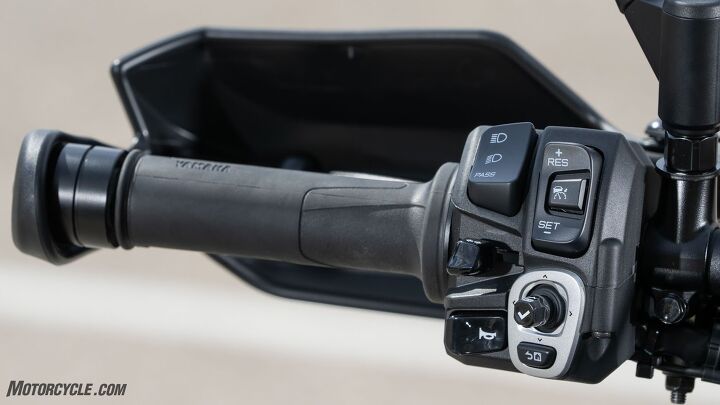




















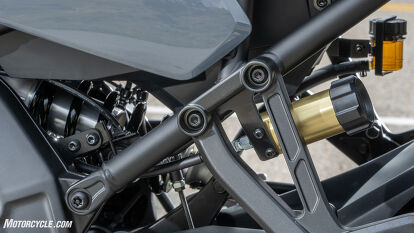

























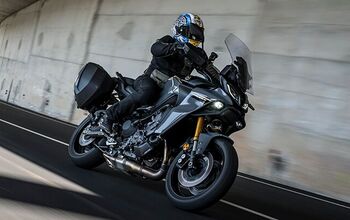





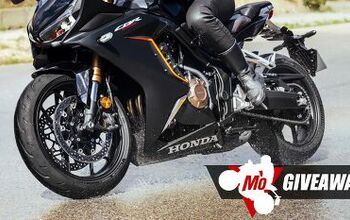

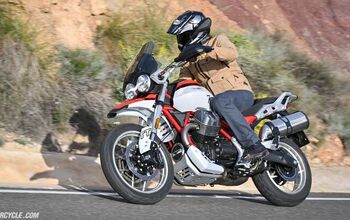



Comments
Join the conversation
used is the way to go - '16-'17 ktm super duke gt w/better performance, no weight fuel economy penalty, holds a gallon more gas, and can be had for thousands less.
nothing against this bike, but....
I enjoyed the review, especially the detailed information concerning the GPS system. I was, however, surprised you didn’t mention that most of the functionality of the system is locked out when the bike is in motion. This is a dealbreaker for me.